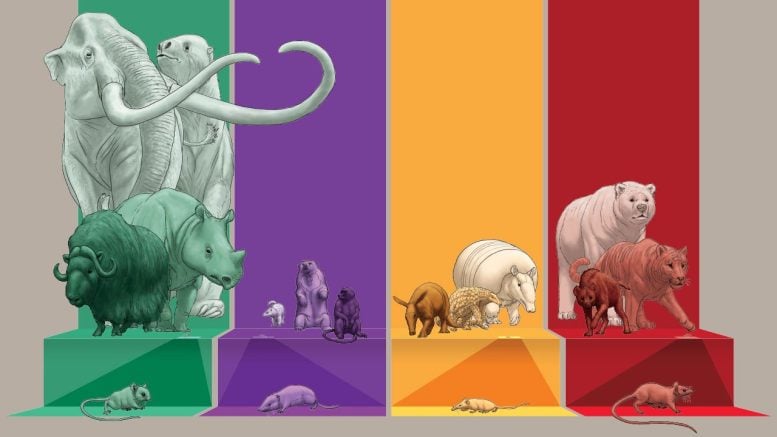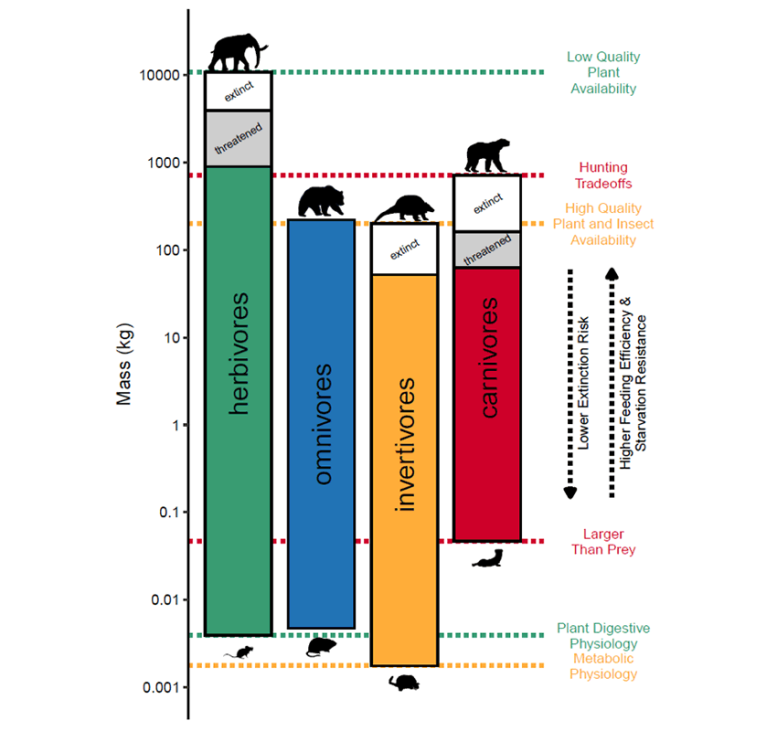Humans Disrupting 66 Million-Year-Old Fundamental Feature of Ecosystems – “This

An illustration featuring mammalian herbivores (green), omnivores (purple), invertivores (yellow) and carnivores (red). Each column includes mammal species lost in the past 2.58 million years (light shade); those expected to be lost in the near future (medium shade, probability of extinction 50%); and those likely to persist (dark shade, probability of extinction <20%). Human-related extinctions of the largest herbivores and carnivores are disrupting what appears to be a fundamental feature of past and present ecosystems, says a new study from the University of Nebraska–Lincoln and institutions on four continents. Credit: Julius Csotonyi / Nature Ecology and Evolution
Diet-size relationship found across deep time, multiple vertebrate groups.
According to a new study, the U-shaped association between diet and size in modern land mammals could also stand for “universal,” as the relationship covers at least 66 million years and a range of vertebrate animal groups.
It’s been several decades since ecologists realized that graphing the diet-size relationship of terrestrial mammals yields a U-shaped curve when aligning those mammals on a plant-to-protein gradient. As illustrated by that curve, the plant-eating herbivores on the far left and meat-eating carnivores on the far right tend to grow much larger than those of the all-consuming omnivores and the invertebrate-feasting invertivores in the middle.
“We’re not sure what’s going to happen, because this hasn’t happened before.” — Will Gearty
To date, though, virtually no research had looked for the pattern beyond mammals or the modern day. In a new study, researchers from the University of Nebraska–Lincoln and institutions on four continents have concluded that the pattern actually dates back to deep time and applies to land-dwelling birds, reptiles, and even saltwater fishes.
However, the study also suggests that human-caused extinctions of the largest herbivores and carnivores are causing a disruption in what appears to be a fundamental component of past and present ecosystems, with potentially unpredictable implications.
“We’re not sure what’s going to happen, because this hasn’t happened before,” said Will Gearty, a postdoctoral researcher at Nebraska and co-author of the study, published April 21 in the journal Nature Ecology and Evolution. “But because the systems have been in what seems to be a very steady state for a very long time, it’s concerning what might happen when they leave that state.”
Size up, size down
The evolutionary and ecological histories of animal species can be told in part through the intertwined influences of diet and size, Gearty said. A species’ diet determines its energy consumption, which in turn drives growth and ultimately helps dictate its size. Yet that size can also limit the quality and quantity of food available to a species, even as it sets thresholds for the quality and quantity needed to survive.
“You can be as big as your food will allow you to be,” Gearty said. “At the same time, you’re often as big as you need to be to catch and process your food. So there’s an evolutionary interplay there.”

A figure illustrating the U-shaped relationship between diet and size (or mass, in kilograms) among land-based mammals. The gray portions of the bars represent species currently under the threat of extinction, with the white portions accounting for species that have already gone extinct. Credit: Nature Ecology and Evolution / Springer Nature
Because the plant-based diet of herbivores is relatively poor in nutrition, they often grow massive for the sake of covering more ground to forage more food — and accommodating long, complex digestive tracts that extract maximum nutrients from it. Carnivores, meanwhile, must grow large enough to both keep up with and take down those herbivores. Though the buffet-style menu of omnivores usually keeps their stomachs full, their high energy demands generally leave them focusing on nuts, insects and other small, energy-dense foods. And while invertivores enjoy mostly protein-rich prey, the diminutive nature of that prey, combined with stiff competition from many other invertivores, relegates them to the smallest sizes of all.
The ultimate result: a U-shaped distribution of both average and maximum body sizes in mammals. To analyze the generalizability of that pattern in the modern day, the team compiled body-size data for a huge number of surviving species: 5,033 mammals, 8,991 birds, 7,356 reptiles, and 2,795 fishes.
“It is really interesting, and really striking, to see that this relationship persists even when you have other dominant animals around.” — Will Gearty
Though the pattern was absent in marine mammals and seabirds, probably due to the unique demands of living in water, it did emerge in the other vertebrate groups — reptiles, saltwater fishes and land-based birds — examined by the team. The pattern even held across various biomes — forests vs. grasslands vs. deserts, for instance, or the tropical Atlantic Ocean vs. the temperate North Pacific — when analyzing land mammals, land birds and saltwater fishes.
“Showing that this exists across all these different groups does suggest that it is something fundamental…
Read More:Humans Disrupting 66 Million-Year-Old Fundamental Feature of Ecosystems – “This
